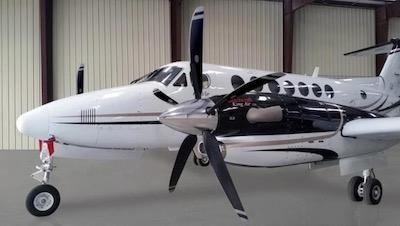Hartzell Propeller Has Built A Better Propeller, Will Customers Beat A Path To Their Door?
By Bruce Brandon
Hartzell Propeller has teamed up with Raisbeck Engineering of Tukwila, Washington to produce a new swept five blade composite propeller for Beechcraft’s King Air 350 workhorse. Unlike some composite propellers which contain wood, Hartzell uses only carbon fiber, epoxy, and stainless steel, 100% aerospace grade materials, enabling the most efficient and durable blade shapes.

Propellers are hardly new. Orville and Wilbur’s propellers were a marvel of efficiency when operating at 10- 20 mph on their first flight. They were within a few per cent of the efficiency of current propellers in that flight regime.
Because a King Air 350 doesn’t operate in that regime, its propellers must be a bit more sophisticated. Hartzell has applied the latest technology to improve the performance and esthetics of the 350. It does so by making the new propeller lighter by 23 pounds per side, adding a fifth blade, and sweeping the blades. Each of these additions contribute to the 350 having improved performance and create a better passenger experience.
Because it is too expensive to recertify a 350’s entire POH, the STC, which is expected in August, will only state that the performance is as good or better than the OEM performance. So, what do you get other than a weight reduction?
Orville and Wilbur recognized that a propeller is a rotating wing. By Hartzell curving the blades, they can be slightly longer and maintain adequate ground clearance. They are also narrower. By narrowing and lengthening the blade, it has a higher aspect ratio which increases efficiency. The higher blade count also causes the sound from the prop tips to be a higher frequency. This results in increased attenuation of the noise before it reaches the interior cabin. While the decrease of 1-3 decibels sounds (pardon the pun) deminimus, anecdotal evidence indicates that this is quite noticeable by passengers.
Adding the fifth blade also helps significantly takeoff and landing performance. Testing has shown that under certain conditions, takeoff rolls may be reduced by 500-700 ft. and landing distance may be reduced up to 700-900 ft.
While anticipated cruise speed will increase probably only a few knots, climb performance may be improved by up to 10%.
One of the advantages of being a composite is that, unlike aluminum propellers, when there is a nick, rather than filing it down resulting in a smaller propeller that, at some point, will have been reduced in size to the point that it is no longer airworthy, Hartzell’s new composite propeller can have a life time of airworthiness. This is because nicks are simply filled in with composite material bringing it back to its original size. This can be repeated indefinitely. Additionally, there is an erosion mesh screen on the exterior of the blades and a replaceable hard nickel-cobalt leading edge to help prevent FOD damage.
The TBO is 6 years or 3,000 hours, whichever occurs first and can be overhauled indefinitely.
An added plus is that these new propellers have a futuristic look that makes the 350 look like the state of the art airplane it is.
Hartzell certified its first composite propeller in 1978 and has composite propellers with over 50,000 hours. This is a fitting addition to a long lineage of successful propellers.
(Image from file)
 Unfortunate... ANN/SportPlane Resource Guide Adds To Cautionary Advisories
Unfortunate... ANN/SportPlane Resource Guide Adds To Cautionary Advisories ANN FAQ: Turn On Post Notifications
ANN FAQ: Turn On Post Notifications ANN's Daily Aero-Term (04.29.24): Visual Approach Slope Indicator (VASI)
ANN's Daily Aero-Term (04.29.24): Visual Approach Slope Indicator (VASI) ANN's Daily Aero-Term (04.28.24): Airport Marking Aids
ANN's Daily Aero-Term (04.28.24): Airport Marking Aids ANN's Daily Aero-Linx (04.28.24)
ANN's Daily Aero-Linx (04.28.24)



